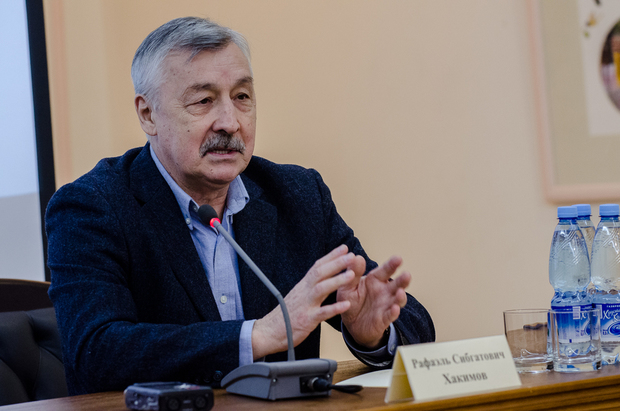Tartarica atlas will tell the Turkish about the Tatars
A unique project will be in Turkish and at the Turkish expense
A Tatarstan-Turkey project – issue of Tartarica atlas in Turkish – was announced in Kazan. As it turned out, it was the initiative of the Turkish side. Kastamonu and the Union of Turkish World Municipalities became the sponsors. Sh. Mardjani Institute of History of the Academy of Sciences of Tatarstan is issuing the first edition. Turhan Dilmaç, the Turkish Consul General, thinks his compatriots need such projects to know the Tatars better. And Rafael Khakimov supposes initiatives help the Turkish in work in Russia and in general.
Issue of atlas for love to the Tatars
Common projects of the two countries in culture have revived with a noticeable warming of relations between Russia and Turkey. A project of issue of Tartarica historical atlas has been one of them. The Union of Turkish World Municipalities and Sh. Mardjani Institute of History are fulfilling the project. One of the residents of Alabuga SEZ Kastamonu from Turkish HAYAT holding became the sponsor. The director of Sh. Mardjani Institute of History of the Academy of Sciences of Tatarstan Rafael Khakimov and Consul General of Turkey to Kazan Turhan Dilmaç personally came to an agreement on the project.
'It was our idea,' says Turhan Dilmaç. 'When I met with Mr Khakimov for the first time, I told about our interest in the creation of Tartarica atlas in Turkish. Then I met with Kastamonu Entegre. They expressed their interest. And it has reached this stage. We have three partners: Sh. Mardjani Institute of History, Kastamonu and the Union of Turkish World Municipalities.'
The Consul told that after he studied Tartarica atlas, he came to the conclusion that there was an affinity between the Turkish and the Tatars in the past, which is very interesting from a historical perspective. What is more, the Tatars are not well known, in spite of the fact that people in Turkey like them.
As for the financing, Kastamonu pays only for the translation. The Union of Turkish World Municipalities will be responsible for the print.
'It is a very big colourful 2,5-3 kg book – a big atlas'
The very atlas is a big project of the Academy Sciences of the Republic of Tatarstan.
'We printed Tartarica atlas, the history of the origin of the Tatars in Russian several years ago. It was in 2008 or maybe a bit earlier,' Rafael Khakimov told Realnoe Vremya. 'A great number of maps is the great value of the book. It is shown how Eurasia changed from a perspective of its population. One can know much about our culture. It is a very colourful book that tells about Turkic people from the 3 rd century till today: about the Huns, all kaghanats, where and what tribes moved, who attacked whom and what weapon used. It is a very big colourful 2,5-3 kg book – a big atlas. There are many maps. The language is simple. The Turkish and the Azerbaijanis don't have such a book. And it is interesting for them. Many people like such books: historians, creative community, especially those who shoot films.'
Khakimov said the books were sold like hot cakes even if the book had 10,000 copies. And 2,000 copies were printed additionally. The book was sold for about 4,000 rubles, Khakimov remembers and emphasises that now these books have exorbitant prices in the black market – from 15,000 rubles. 'We would reprint a simpler version of this book themselves: we would reduce the amount of archaeological information, remove maps of districts. So the book would be lighter and smaller. The Ministry of Education would pay a part of the costs and be interested in science: some villages of the republic could find itself on the map,' explains Khakimov. He noted that many books were sent to schools and libraries of Tatarstan.
'The oil industry of Tatarstan had sponsored the printing of the book. They said they did not care about the price. The most important thing was to have a unique book,' the director of the institute tells and notes that two unique and the only Russian experts in cartography from Moscow took part in the creation of the book. 'Uniqueness is also important to the Turkish.'

'When the jet was downed, the Turkish workers were not dismissed in Tatarstan'
The project of printing of Tartarica atlas in Turkish is not new: it began before the estrangement 1,5 years ago… 'The translation of the texts has almost finished. Now the maps are translated, it is a very finicky job,' Khakimov tells. The work with the maps will take about 3-4 months.
The Consul told the presentation of the book will be in Istanbul in Dolmabahçe Palace.
The number of copies of the book in Turkish is unknown at the moment. But the first examples will be presented to high-ranking people who will assist the presentation.
Rafael Khakimov thinks the initiative of the Turkish can be explained: It is an ad. Tatarstan for the Turkish is a 'window to Russia'. When the jet was downed, the Turkish workers were not dismissed in Tatarstan. This is why today we are the first people to start the cooperation. The investments are good for them.'
Both Dilmaç and Khakimov admitted new ideas and projects are under discussion. But it is early to make them public.